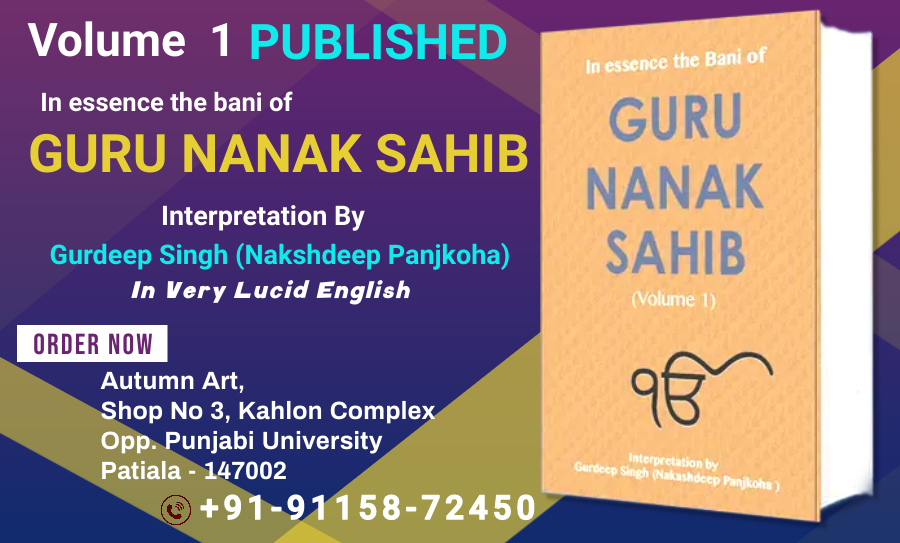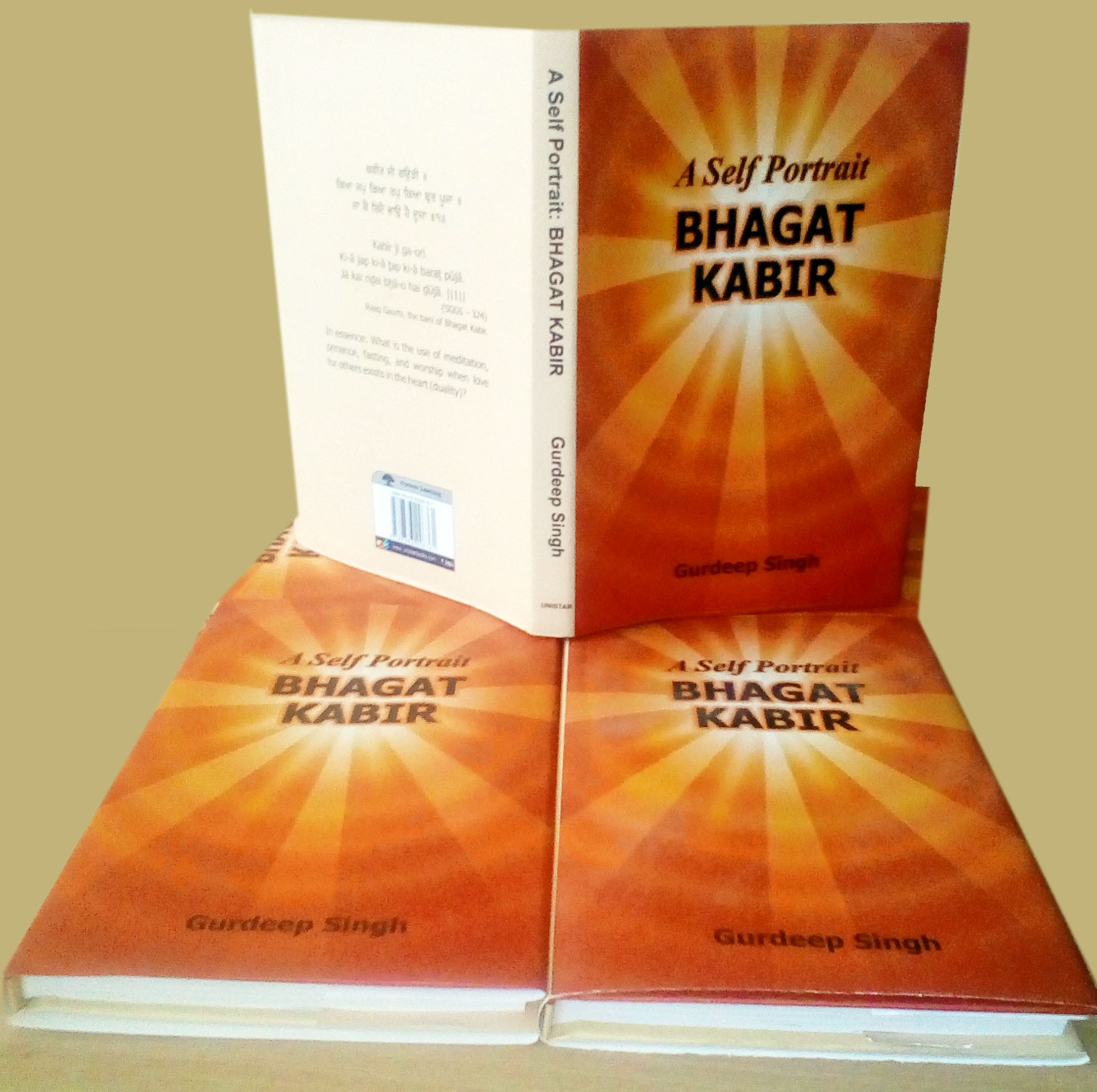If someone is only interested in playing with the words, I doubt, he or she will ever address in serious way the message Guru Nanak wants to convey in JapJi (through out Sri Guru Granth Sahib), Sri Guru Granth Sahib is not a story of enlightened ones or rules and laws of this faith to control human souls but a detailed description of the beloved Creator for whom, enlightened ones fell for and in that love, they reacted towards prevailed religious practices of various faiths in their times. So we need to start to understand the Creator with whom the enlightened Gurus and Bhagatas fell in love. Guru Nanak’s point of views about the Creator, is deemed as the basis of His identity in Gurmat, no wonder this short or full version[in the beginning of Jap Ji] about His identity, is used in the beginning of every Shabada and specially named Bani. Since ideas about Him and about other numerous prevailed religious practices, are linked to Him, He must be defined at least through the words that can express the Inexpressible to some extent as per their (words) limits. Let’s try to understand that description of Him by Guru Nanak
ੴ ਸਤਿ ਨਾਮੁ ਕਰਤਾ ਪੁਰਖੁ ਨਿਰਭਉ ਨਿਰਵੈਰੁ ਅਕਾਲ ਮੂਰਤਿ
ਅਜੂਨੀ ਸੈਭੰ ਗੁਰ ਪ੍ਰਸਾਦਿ ॥
Ik▫oaʼnkār saṯ nām karṯā purakẖ nirbẖa▫o nirvair akāl mūraṯ
ajūnī saibẖaʼn gur parsāḏ.
ੴ, Before Guru Nanak, there was “ONkaar” it was indeed used for the Creator but Guru Nanak used ” ੧” with Onkaar, it consists of two parts, first is, ”Om” and the second is “Kaar”, OM has been used for the Creator, it has been also used in Gurbani as “the beginning”(1061 SGGS) “Kaar” is described by Bhai Veer Singh Ji as “only one special”[Sri Guru Granth Sahib Kosh-51], Dr Sahib Singh Ji describes it as,” equally pervading”. Here Guru Nanak adds “,੧”, means, “one”, in simple words as per Guru Nanak,” Akalpurakh is the only one who pervades all over equally”, Guru Nanak further calls Him “an existing reality” by using the word,” ਸਤਿ ਨਾਮੁ Naam”, here it represents the Creator and all the name given to Him. Gurus and Bhagatas call Him with numerous names; many of such names were attached to exceptional personalities of the History of India and other lands; that is why they all stress on calling Him as “all pervading” to separate Him from all others who bore these names[ for example on 436 and 469 SGGS]
“ਸਤਿ” conveys many kinds of meanings like “true, charity, good deeds etc and all pervading reality ” it depends in what context it is used, here it is used with “Naam” obviously it is about Him, therefore its meaning has more depth here, “Satt” originates from Sanskrit word”, Sattya” which means that who/which has existence(Dr Sahib Singh) and this existence is, “all pervading truth”(Bhai Veer Singh Ji), so it means “Akalpurakh is an existing reality not a myth”
“ਕਰਤਾ ਪੁਰਖੁ”, it has two words, “ਕਰਤਾ” means creator, ਪੁਰਖੁ is used most of the times for a man but it is also used for “supreme Soul”, in Bhagwat Gaeta and Raghuwansh, it is used for “soul”(Dr SSJi), In Sri Guru Granth Sahib, it is used for “all pervading soul/light”(SGGS 291). Now look, here how does Guru Nanak stress on Akalpurakh’s “being active as a creator”, after that, next follow His qualities known but not seen often in humans and these qualities are very important to obtain to envision Him, this fact is repeatedly elaborated in various Shabadas in Sri Guru Granth Sahib.
“ ਨਿਰਭਉ ਨਿਰਵੈਰੁ “.ਨਿਰਭਉ means fearless, means the Creator has no fear of any one. ਨਿਰਵੈਰੁ, means the one who doesn’t hold any kind of grudge or animosity against any one. As He is the Creator of all, why should He fear from any one, and as He is an active creator of all, good and evil, why He should keep grudge or animosity against any one, after all, the total creation is His own in which He permeates. His devotees earn these qualities through meditating on Him in utter sincere love with His grace, when one chooses to side with the fearless Creator who is without animosity, one must become like Him in one’s behavior. Guru further describes His eternity.
“ਅਕਾਲ ਮੂਰਤਿ ” . ਅਕਾਲ means beyond times, ਮੂਰਤਿ means “form”, so it means His form is beyond times, this is also further described in first sloka of “Jap Ji”, it is stressed that never ever, the Creator dies as mortals do, time has no effect on Him, why? Its answer is expressed in the next word.
“ਅਜੂਨੀ ਸੈਭੰ ” . ਅਜੂਨੀ, means beyond birth. Whoever takes birth has to die period; however, Akalpurakh is beyond times because He doesn’t take birth. If that is the case, how did He come into existence? This question, Guru Nanak answers in the word, “ਸੈਭੰ” which means “ He exists from His own- self or light”, so there is nothing that He came from into existence as we do from father and mother, or a pot from soil and water. This word dispels all illusions created about His existence.
As stated above, He is “all pervading Creator ਕਰਤਾ ਪੁਰਖੁ . Who pervades all over, cannot be in only one body or a place, period. When the enlightened ones and His true devotees are addressed as “Him”, it is simply about His obvious manifestation in them that proves them totally unique like Him from the rest of the population. In whoever He manifests, is worth to have extreme reverence because that enlightened one has obtained numerous virtues including of His virtues as “being beyond fear and animosity”. Usually in this world, all have fears of different kinds and all bear animosity towards someone in different ways but that is not the case with His true devotees because they become like Him by obtaining virtues stated above (397 SGGS).
“ ਗੁਰ ਪ੍ਰਸਾਦਿ “.ਪ੍ਰਸਾਦਿ means with blessings, ਗੁਰ means Guru’s, in what context Guru’s blessings are weighed here? Actually after expressing Akalpurakh, Guru Nanak states here that He, who is expressed here, is known through Guru’s blessings only. This statement is repeatedly elaborated through Sri Guru Granth Sahib (for a few examples, especially in Asa Dee Vaar, also on 399, 444, 1237, 1268, 1328-29 SGGS)
So Guru Nanak has expressed the Almighty he has realized after falling in love with Him and has pointed out how He could be known. In JapJi, stanza, up to stanza 2 Guru Nanak stresses on His infinity and His infinite Ordinance by rejecting some prevailed practices to know Him, then Guru advises his followers to turn towards those who sing His praises but that is also as per His set up limits, right there, Guru inserts His advice how to please Him by understanding His Ordinance [up to stanza 4] After advising his followers to understand His Ordinance, Guru asks the followers to sing His praise that carries miracles of transforming lives through the power of Guru. That is a kind of interpretation of ਗੁਰ ਪ੍ਰਸਾਦਿ [ up to stanza 5] Then Guru’s thoughts again go to His inexpressible virtues in contexts of those mortals who did some efforts in this regards, then he stresses on the miracles in hearing His Name[ up to stanza 11]. The faith in Him and Guru should be unshakable, once it is obtained, life takes different turn.[12 13, 14 15], Guru Nanak stresses to have unshakable faith in Him which comes only if the intellect, totally wrapped in so called rationality,[ bear in mind, all talk about Him surpasses rational concepts here], is abandoned [ stanza 1] After that Guru Nanak keeps describing His creation and others’ given thoughts or their failures in describing the origin of His creation. During this flow of thoughts, reason is used but also it is given up when it doesn’t measure up to His Ordinance in context of His creation,thus personal experience is shared with followers. In His creation, He is kept present all the time as “Ekkankaar and active Karta Purakh”[ up to stanza 19]
After describing His unlimited virtues and people’s various prevailed practiced -rituals and efforts to pursue Him[ up to stanza 22], His power beyond expression in context of people’s lame- claims about Him and His Infinity are expressed, His ever presence is also defined there as well [up to 29 Stanza] His immense power in the context of His -set up -creation is described [ up to stanza 33] Then Guru Nanak takes his followers to different realms through which He is known step by step by securing Divine knowledge about Him and the progression of the soul after obtaining this knowledge[ up to stanza 37]
So what we see here in JapJi, is His description in a possible way like His being immaculate though He pervades everywhere [stanza 5]. His being “Akalmurat” is elaborated in first sloka”
ਆਦਿ ਸਚੁ ਜੁਗਾਦਿ ਸਚੁ ॥
ਹੈ ਭੀ ਸਚੁ ਨਾਨਕ ਹੋਸੀ ਭੀ ਸਚੁ ॥੧॥
Āḏ sacẖ jugāḏ sacẖ.
Hai bẖī sacẖ Nānak hosī bẖī sacẖ. ||1||
In Essence: Akalpurakh has been there in prime-time, from the beginning throughout all ages, Nanak says He is today and will be ever.
So basically it is stressed that only Akalpurakh is eternal.
“ਅਜੂਨੀ ਸੈਭੰ” is elaborated in stanza 5,
ਥਾਪਿਆ ਨ ਜਾਇ ਕੀਤਾ ਨ ਹੋਇ ॥
ਆਪੇ ਆਪਿ ਨਿਰੰਜਨੁ ਸੋਇ ॥
Thāpi▫ā na jā▫e kīṯā na ho▫e.
Āpe āp niranjan so▫e.
In Essence: He neither can be established nor be created; the pure Creator is from His own self/light.
As He is an active Creator, His creation is under His Ordinance, no one is beyond that but His Ordinance cannot be expressed either like Him [stanza 2] Only He is active creator [Karta Purkh] and only He is the Giver [stanza7]
In Stanza 24, Guru Nanak makes it clear that only He Himself knows His infinity, the enlightened ones and others try to express Him as per their given ability [on 631 SGGS]
Now comes the question of His being permeated in forms, also known as His Sargun Sroop( With Form) which literally is expressed in the word, “Onkaar (Ekkankaar)” , in all visible or invisible,His live presence exists.
Onkaar conveys the meaning of His being all pervading, it establishes His presence in all, and therefore there is no place without Him, stanza 9 Jap Ji
ਜੇਤਾ ਕੀਤਾ ਤੇਤਾ ਨਾਉ ॥
ਵਿਣੁ ਨਾਵੈ ਨਾਹੀ ਕੋ ਥਾਉ ॥
Jeṯā kīṯā ṯeṯā nā▫o.
viṇ nāvai nāhī ko thā▫o.
In Essence: All His creation, is His manifestation/form/filled with His presence, there is no place without Him
Gurus and Bhagatas express well in various ways in many Shabadas about the Creator and His “Sargun swroop (His form)permeating in His creation” So to see Him only separated from His creation is not right as Guru Nanak himself states [on 223 SGGS]……….
“From “Guru Message” under publication
Note: Many pronounce “Ikkonkaar” but in Gurbani its’ pronunciation is ” ekkankaar”[ A few examples are on 30. 153, 185. 227, 507, 838. 930. 1039, 1361 SGGS].





